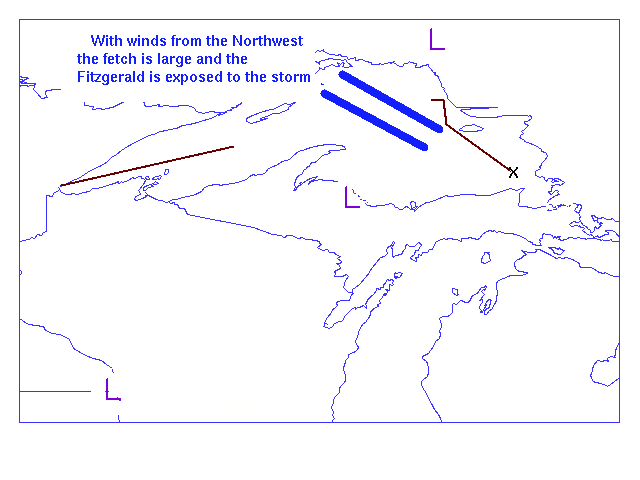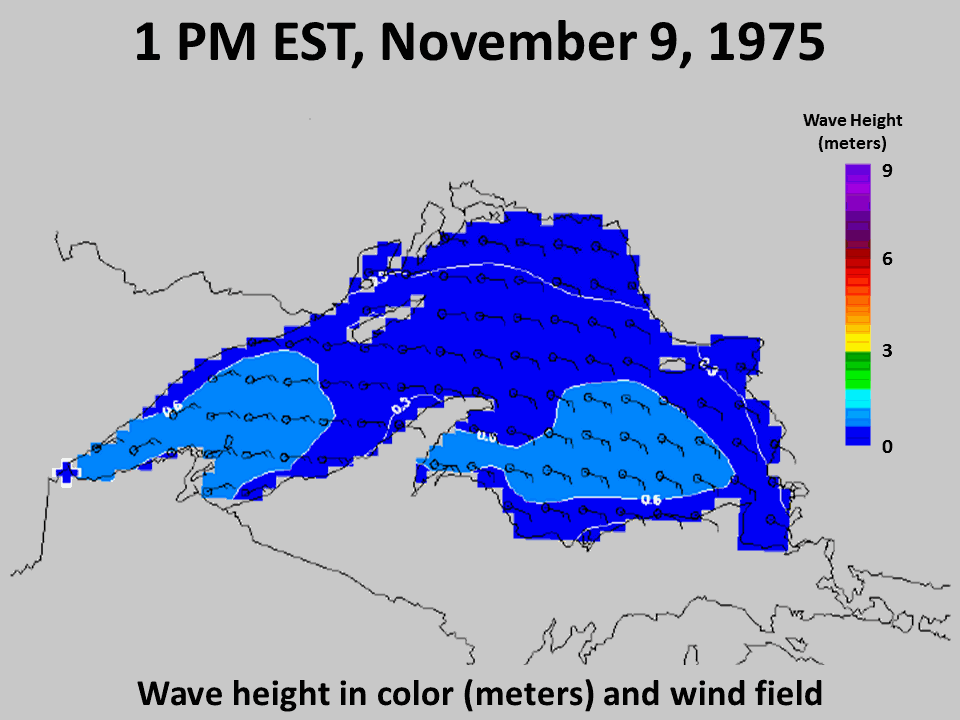


Hurricane-force wind gusts, with waves over 25 feet high, are not the usual conditions one associates as being possible on a "lake." However, these very conditions were being experienced at the time the freighter ship SS Edmund Fitzgerald sank on November 10, 1975 in southeastern Lake Superior. 29 crewmen lost their lives in the wreck of the Fitzgerald, which is still the largest ship to ever sink in the Great Lakes. The extraordinary weather conditions on Lake Superior during that November 1975 storm have always been cited as the major contributing factor in the loss of the ship and her crew. It was not until recent advances in computer weather and wave modeling that the true severity of the storm could be better understood.
Route of the Fitzgerald and Storm Track - Source: SSEC (U-WI)

The Fitzgerald was a freighter ship designed to haul iron-ore from mines near Superior, WI and carry it to ports like Detroit, MI where this iron ore would be used to make steel. On the afternoon of November 9, 1975, the ship set out on just such a voyage. Traveling nearby the Fitzgerald for this voyage would be another cargo ship the SS Arthur M. Anderson. At the same time, a low pressure system was rapidly developing across the southern Plains and working northeastward toward the Great Lakes. Conditions would gradually deteriorate as the center of low pressure got closer to the eastern end of Lake Superior. By the time the two ships reached southeastern Lake Superior, the evening of November 10th, the Anderson reported wind gusts as high as 86 mph and significant wave heights (average of the largest 1/3 of waves, measured trough to crest) of 18 to 25 ft.

Wave Fetch Diagram - Source: Washington State Dept. of Ecology
The height of wind-driven waves on a body of water is determined largely by wind speed and its duration, along with the “fetch,” or distance of open water exposed to the wind. By the time the Fitzgerald reached the southeastern end of Lake Superior, the evening of Nov. 10, 1975, it happened to be in the “sweet spot” to experience some of the largest waves that the largest freshwater lake can deliver. At that moment in the storm’s evolution, the center of the surface low was located northeast of Lake Superior. On the southern side of the low, winds would be hitting the ship out of the west-northwest. In this way, the wind was afforded a fetch distance of about 185 miles; a sufficient distance with sustained winds over 45 mph to produce significant wave heights of 25 ft.
Wind Fetch/Ship Position the Evening of Nov. 10, 1975 - Source: SSEC (U-WI)

During the storm of November 9-11, 1975, there were only 31 weather observations taken by ships on Lake Superior. Considering the size of this largest freshwater lake in the world, this averages to one observation per hour over an area the size of the state of South Carolina. However, inputting the upper-air and surface weather conditions into modern computer weather and wave models gives a much clearer view of the exact conditions probably experienced by the Fitzgerald when it sank. Below is a computer simulation of significant wave height. In this view, the location of the Fitzgerald is indicated by the blue cross. This simulation clearly shows that the ship unfortunately sailed into the area of largest storm waves the evening it sank, with waves of over 7.5 meters or 25+ ft.

Computer Modeled Winds and Wave Height Nov. 9-11, 1975 - Source: Hultquist, et al. (2006)
Aside from experiencing waves of 25 ft, there is also a chance, thanks to a better understanding of wave dynamics today, that the crew may have encountered isolated waves even higher, called “rogue waves.” For many years, rogue waves were discounted by scientists as sailors’ tall tales or myths. However in 1995, a rogue wave was measured for the first time by a sensor on an offshore oil platform off the coast of Norway. In this case, the “background,” or significant wave height, was 12 meters (39 ft). The single rogue wave, though, reached an incredible 25.6 meters (84 ft) in height from crest to trough. Subsequently, using global satellite studies, the rogue wave has been defined as any wave more than 2 times the significant wave height. Thus in the case of the Fitzgerald, it could have encountered a rogue wave well over 25 ft during the storm.
Draupner Platform Rogue Wave Time Series - Source: Haver (2004)
Along with weather being the main contributor in the loss of the Fitzgerald, unsafe cargo load levels, running aground due to inaccurate lake depth charts, as well as hatch cover failure have all been investigated over the years as secondary contributing factors in the sinking. While evidence supporting each of these secondary theories has been found, not one of these alternatives has been shown to be the ultimate cause of the sinking.
The sinking of the SS Edmund Fitzgerald was a weather-related disaster so significant that a well-known hit song, “The Wreck of the Edmund Fitzgerald," was recorded by Canadian singer-songwriter Gordon Lightfoot. Since the disaster, much has been learned about weather and waves to show how the ship and her crew happened to sail into the wrong place at the wrong time that stormy November evening. While there are still many questions as to further causes of the sinking, one thing is certain; a storm on the Great Lakes can definitely live up to its colloquial name, the “Witch of November.”
Further Reading:
NWS - Marquette, MI
SSEC - University of Wisconsin - Madison
CIMMS - University of Wisconsin - Madison
Bulletin of the American Meteorological Society